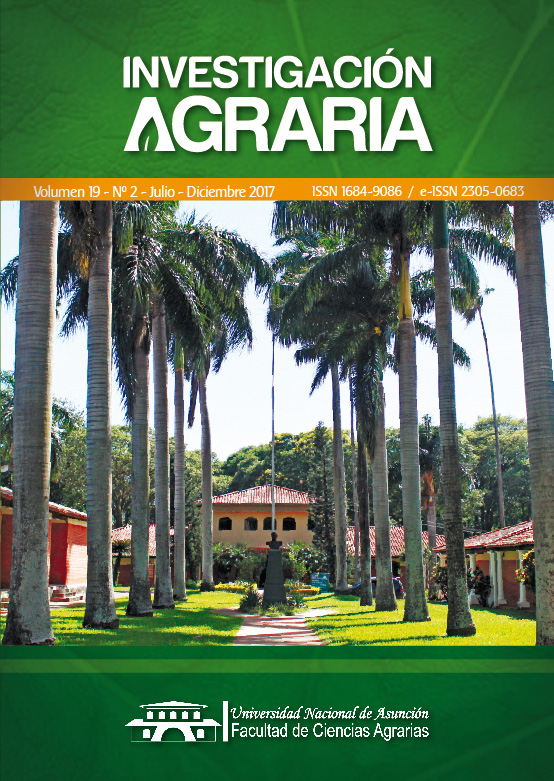Molecular identification and growth rate of native strains of Trichoderma spp. isolated from the Northern Region of Paraguay
DOI:
https://doi.org/10.18004/investig.agrar.2017.diciembre.127-132%20Keywords:
Trichoderma asperellum, Trichoderma erinaceum, Biological ControlAbstract
The fungi of the genus Trichoderma, due to its cosmopolitan distribution, rapid growth and abundant production of spores, are ideal candidates for applications in biological control programs in different habitats. With the objective of molecularly identify strains of Trichoderma spp. and evaluate the in vitro effect of temperature on growth and appearance of colonies, an investigation was conducted at the Laboratory of Plant Pathology Research Capitan Miranda Investigation Center (CICM) belonging to the Paraguayan Institute of Agricultural Technology (IPTA), located in the district of Capitán Miranda, Itapúa Department, Paraguay. The growth rate and colony appearance was determined by culturing on potato dextrose agar at 25, 28 and 31 ° C and the molecular identification at the species level was performed by analyzing the nucleotide sequences performed in Blastn. Of the seven strains, six (MS9, MS10, MS12, MS15, MS16 and MS19) correspond to T. asperellum and the remaining (MS28) to T. erinaceum with an identity of 100%. The optimum growth temperature for all strains tested was 25 to 28 ° C (fast growing). The strain T. asperelleum obtained the highest growth rate being MS10 - MS15 the highest growth rate at 25 ° C (24.19 and 23.85 mm.día-1), MS16 - MS10 at 28 ° C obtained a CT 26.39 and 26.11 mm.día-1 and 31 ° C the strains MS19 - MS9 had a CT scan of 7.05 and 6.78 mm.día-1.Downloads
Metrics
References
Almeida, ÁM; Abdelnoor, RV; Arias, CAA; Carvalho, VP; Jacoud, DS; Marin, SR; Carvalho, CG. 2003. Genotypic diversity among Brazilian isolates of Macrophomina phaseolina revealed by RAPD. Fitopatologia Brasileira 28(3):279-285.
Antal, Z; Manczinger, L; Szakacs, G; Tengerdy, RP; Ferenczy, L. 2000. Colony growth, in vitro antagonism and secretion of extracellular enzymes in cold-tolerant strains of Trichoderma species. Mycological Research 104(05):545-549.
Babu, BK; Saxena, AK; Srivastava, AK; Arora, DK. 2007. Identification and detection of Macrophomina phaseolina by using species-specific oligonucleotide primers and probe. Mycologia 99(6):797-803.
Choi, IY; Hong, SB; Yadav, MC. 2003. Molecular and morphological characterization of green mold, Trichoderma spp. isolated from oyster mushrooms. Mycobiology 31(2):74-80.
Danielson, RM; Davey, CB. 1973. Non nutritional factors affecting the growth of Trichoderma in culture. Soil Biology and Biochemistry 5(5):495-504.
Gams, W; Bisset, J. 1998. Morphology and identification of Trichoderma. In Harman, GE; Kubicek, CP. eds. Trichoderma and Gliocladium. London. Taylor and Francis. p.3-34.
Grondona, I; Hermosa, R; Tejada, M; Gomis, MD; Mateos, PF; Bridge, PD; Monte, E; Garcia-Acha, I. 1997. Physiological and biochemical characterization of Trichoderma harzianum, a biological control agent against soil borne fungal plant pathogens. Applied and Environmental Microbiology 63(8):3189-3198.
Harrington, TC; Steimel, J; Workneh, F; Yang, XB. 2000. Molecular identification of fungi associated with vascular discoloration of soybean in the north central United States. Plant Disease 84(1):83-89.
Hermosa, MR; Grondona, I; Iturriaga, ET; Diaz-Minguez, JM; Castro, C; Monte, E; Garcia-Acha, I. 2000. Molecular characterization and identification of biocontrol isolates of Trichoderma spp. Applied and Environmental Microbiology 66(5):1890-1898.
Hjeljord, L; Tronsmo, A. 1998. Trichoderma and Gliocladium in biocontrol: an overview. In Kubicek, CP; Harman, GE. eds. Trichoderma and Gliocladium . London, United Kingdom. Taylor and Francis Ltd. p 131-151.
Howell, CR. 2003. Mechanisms employed by Trichoderma species in the biological control of plant diseases: the history and evolution of current concepts. Plant disease 87(1):4-10.
Iqbal, U; Mukhtar, T. 2014. Morphological and pathogenic variability among Macrophomina phaseolina isolates associated with mungbean (Vigna radiata L.) Wilczek from Pakistan. The Scientific World Journal 2014(2014).
Karthikeyan, B; Jaleel, CA; Lakshmanan, GA; Deiveekasundaram, M. 2008. Studies on rhizosphere microbial diversity of some commercially important medicinal plants. Colloids and surfaces B: Biointerfaces 62(1):143-145.
Küçük, Ç; Kivanç, M. 2003. Isolation of Trichoderma spp. and Determination of Their Antifungal, Biochemical and Physiological Features. Turkish Journal of Biology 27(4):247-253.
Knudsen, GR; Bin, L. 1990. Effects of temperature, soil moisture, and wheat bran on growth of Trichoderma harzianum from alginate pellets. Phytopathology 80(8):724-727.
Kumar, D; Chand, R; Prasad, LC; Joshi, AK. 2007. A new technique for monoconidial culture of the most aggressive isolate in a given population of Bipolaris sorokiniana, cause of foliar spot blotch in wheat and barley. World Journal of Microbiology and Biotechnology 23(11):1647-1651.
Larralde-Corona, CP; Santiago-Mena, MR; Sifuentes-Rincon, AM; Rodríguez-Luna, IC; Rodriguez-Perez, MA; Shirai, K; Narvaez-Zapata, JA. 2008. Biocontrol potential and polyphasic characterization of novel native Trichoderma strains against Macrophomina phaseolina isolated from sorghum and common bean. Applied Microbiology and Biotechnology 80(1):167-177.
Lieckfeldt, E; Samuels, GJ; Nirenberg, H. I; Petrini, O. 1999. A morphological and molecular perspective of Trichoderma viride: is it one or two species?. Applied and Environmental Microbiology 65(6):2418-2428.
Ospina-Giraldo, MD; Royse, DJ; Chen, X; Romaine, CP. 1999. Molecular phylogenetic analyses of biological control strains of Trichoderma harzianum and other biotypes of Trichoderma spp. associated with mushroom green mold. Phytopathology 89(4):308-313.
Qiagen. 2012. Manual del kit QIAamp® DSP DNA Blood Mini. 2 vers. Alemania. 20 p.
White, TJ; Bruns, T; Lee, SJWT; Taylor, JW. 1990. Amplification and direct sequencing of fungal ribosomal RNA genes for phylogenetics. In PCR Protocols: a Guide to Methods and Applications. San Diego. Academic Press. p. 315-322.
Zadoks, JC; Schein, RD. 1979. Epidemiology and Plant Disease Management. New York, United States. Oxford University Press. 427 p.
Downloads
Published
How to Cite
Issue
Section
License
Copyright (c) 2017 Investigación Agraria

This work is licensed under a Creative Commons Attribution 4.0 International License.
All content in this journal is under Creative Commons Attribution License.









 All content in this journal is under
All content in this journal is under 